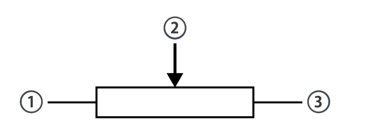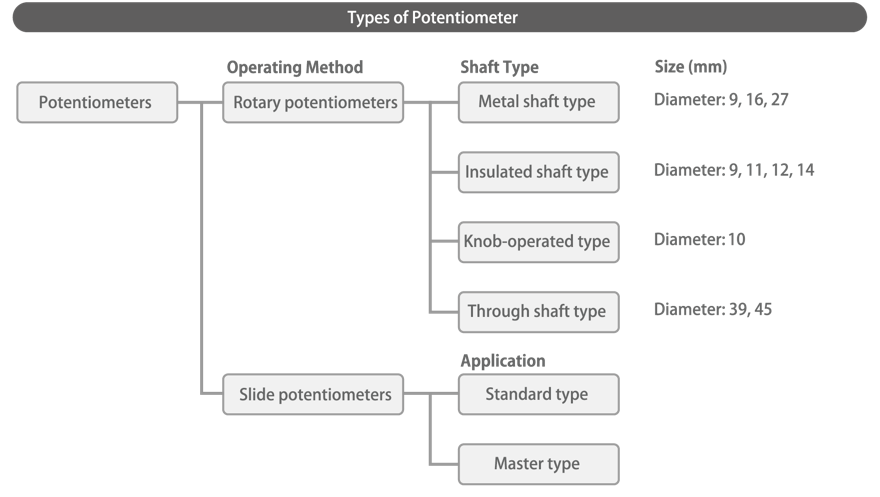A potentiometer is an electronic component that converts a change in mechanical position into an analog electrical signal.
At Alps Alpine, we also refer to potentiometers in Japanese as "boryumu (volumes)" because they are traditionally used in audio equipment to control volume.
As they convert changes in mechanical position into an analog electrical signal, they are also used as position sensors, but here we will explain potentiometers used in control devices.
For more on resistive position sensors, go here.
Principles of a Potentiometer

The principles of a potentiometer are very simple. A constant voltage is applied to terminals (terminals 1 and 3) at opposite ends of a resistive element. A contact (wiper) connected to another terminal (terminal 2) moves over the resistive element. The ratio (%) of the voltage between terminal 1 or 3 and terminal 2 to the applied constant voltage is used to detect the position of the wiper.
The circuit is represented by the diagram on the right.

Potentiometers can be categorized according to how they are operated – rotary types operated by rotating, or slide types operated by sliding.

Basic Electrical Characteristics of Potentiometers
Here we explain the basic electrical characteristics of potentiometers.

・ Nominal Total Resistance (Total Resistance)
The resistance value representing the standard value for a potentiometer is called the nominal total resistance.
Total resistance is the resistance between terminal 1 and terminal 3.
・Residual Resistance
The resistance between terminals 1 and 2 when the wiper is positioned at the terminal 1 end, or the resistance between terminals 3 and 2 when the wiper is positioned at the terminal 3 end, is called residual resistance.
Residual resistance is the minimum resistance value when the wiper is at its minimum or maximum extent of movement.
・Maximum Attenuation
The output voltage ratio (in decibels) when output is at a minimum.
It represents the degree to which the volume of audio equipment can be reduced.
In the context of potentiometers for volume control, maximum attenuation and insertion loss (see below) are used instead of residual resistance.
・Insertion Loss
The output voltage ratio (in decibels) when output is at a maximum.
It represents the degree to which the volume of audio equipment can reach full power.
In the context of potentiometers for volume control, insertion loss and maximum attenuation (see below) are used instead of residual resistance.

・Resistance Taper
The output voltage between terminals 1 and 2 (or between terminals 2 and 3) in relation to the input voltage between terminals 1 and 3, expressed as a percentage. It changes with the position of the wiper, as shown in the resistance taper curves on the right.
A selection can be made, for example, between the B curve, suitable for level adjustment, and the A curve, for sound more natural to the human ear.

・Sliding Noise
This is the slight electrical noise generated as the wiper moves over the resistive element
The bigger the noise, the easier it is for volume control on audio equipment to result in an unpleasant crackling sound.
Types of Potentiometer Supplied by Alps Alpine
Within the larger categories of rotary and slide types, Alps Alpine supplies many different types of potentiometer depending on the application and required characteristics.
Rotary potentiometers have variations in shaft type and dimensions, while slide potentiometers vary according to the application and size.

In addition to potentiometer models listed on the Alps Alpine website, we also support partial customization of the following parameters.
Rotary potentiometers: Shaft length and design, with/without detents, and combination of total resistance and resistance taper
Slide potentiometers: Lever material and design, with/without detents, with/without mounting plate, and combination of total resistance and resistance taper
If you are interested in purchasing a partially customized product, please contact a sales office or distributor.
































